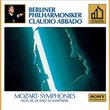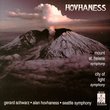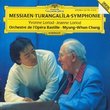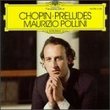| All Artists: Arnold Bax, David Lloyd-Jones, Royal Scottish National Orchestra Title: Bax: Symphony No. 3 / The Happy Forest Members Wishing: 0 Total Copies: 0 Label: Naxos Original Release Date: 1/1/2000 Re-Release Date: 2/22/2000 Genre: Classical Styles: Forms & Genres, Theatrical, Incidental & Program Music, Historical Periods, Modern, 20th, & 21st Century, Symphonies Number of Discs: 1 SwapaCD Credits: 1 UPC: 730099460828 |
Search - Arnold Bax, David Lloyd-Jones, Royal Scottish National Orchestra :: Bax: Symphony No. 3 / The Happy Forest
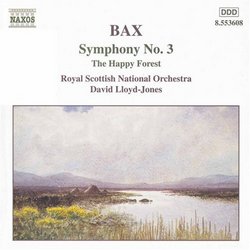 | Arnold Bax, David Lloyd-Jones, Royal Scottish National Orchestra Bax: Symphony No. 3 / The Happy Forest Genre: Classical
Here's an irresistible opportunity to acquaint yourself with one of the most lovable of all British symphonies in a finely engineered performance of infectious dedication and impressive power. Bax completed the third of hi... more » |
Larger Image |
CD DetailsSynopsis
Amazon.com Here's an irresistible opportunity to acquaint yourself with one of the most lovable of all British symphonies in a finely engineered performance of infectious dedication and impressive power. Bax completed the third of his seven symphonies in early 1929. It's one of his very best scores, crammed full of bewitchingly beautiful melody (nowhere more so than in the wonderfully serene epilogue) and thrillingly evocative of the rugged coastline and mountains in and around Morar (Bax's Scottish winter retreat). David Lloyd-Jones's bright-eyed interpretation is, on balance, the most satisfyingly lucid since Sir John Barbirolli's wartime premier recording with the Hallé. Moreover, the Royal Scottish National Orchestra rises to the challenge with unstinting fervor and impressive polish. For a filler we get a enjoyably robust, at times boisterous, reading of the earlier, toothsome tone poem The Happy Forest, its gorgeous central portion lacking just a fraction in rapt wonderment. Overall, though, yet another British music winner from Naxos, and an absolute must at the price. --Andrew Achenbach Similar CDsSimilarly Requested CDs
|
CD ReviewsSplendid Conductorial Control Thomas F. Bertonneau | Oswego, NY United States | 10/05/2000 (5 out of 5 stars) "Two or three of Sir Arnold Bax's (1883-1953) big works suffer from the embarrassment of a too-complicated first movement. The Violin Concerto (1937) is one: Its First Movement consists of an "Overture," so called, interrupted by a "Ballade," so called, interrupted by a Scherzo. The Third Symphony (1929) is another. Here, the First Movement consists of episodes - Lento Moderato... Allegro Moderato... Allegro feroce... etc. - that, unless the transitions come under exceedingly careful control, individually subvert the sense of a unified musical sequence. David Lloyd-Jones' success in the Naxos recording of this symphony arises from his imposition on that wayward opening phase of the Third something like a genuine organic unity. In this he beats out John Barbirolli, Edward Downes, and Bryden Thomson, all of whom over the decades have also set down playback versions of this score. Lloyd-Jones discovers the First Movement's unity in the derivation of all its episodes from the serpentine bassoon melody with which it commences. This twisting minor-key improvisation almost immediately forms a canon with the other woodwinds, and eventually develops into a fully fledged orchestral fugue. Again, Lloyd-Jones understands that the stretto of the fugue is the climax of the movement, the rest being denouement. With the central slow movement of the Third, no problem exists, as in the First Movement. This is a nocturne, as crystalline and timeless as anything that the obsessively otherworldly Bax ever wrote. Our insightful conductor also takes the Finale with a clear view of its inner-structure and its relation to the first two parts of the symphony. The "Epilogue" of the Third is legendary; so poignantly beautiful did it strike the early auditors of this work that one of them, Ralph Vaughan-Williams, quoted it in his own Piano Concerto, although he later rewrote the work so that the allusion to Bax was less direct quotation than passing reference. It is a shame that the usually intractable First Movement of the Third has kept it from a firmer place in the repertory. And yet, of the seven Bax symphonies, the Third has been the most frequently played in the concert hall. Naxos appends Bax's sunny orchestral sketch, "The Happy Forest," inspired by Theocritus and Swinburne, among others, as the honorable makeweight of this recorded program. It's well worth exploration and cheap at the price." Bax would have approved of this! wilde-one | 08/11/2001 (5 out of 5 stars) "Bax's third symphony is not an easy work; it is full of tempo changes and subtle rubati that make the job of the conductor difficult. From the interpretation viewpoint, it is compounded by the total absense of metronome markings in the score.David Lloyd-Jones does an excellent job. But what persuades me about his version is that it most closely approximates John Barbirolli's interpretation back in the early 1940s. Bax had heard this symphony performed many times in the 1930s (it was famous enough for the British Council to award it a recording grant); he was a friend of Barbirolli and it is fair to say that Barbirolli's version closely met with Bax's approval.Lloyd-Jones' reading is certainly an improvement over the quirky, idiosyncratic version put out by Bryden Thomson (and recorded in an echoing acoustic that makes a mess of Bax's harmonic rhythm (and even the physical rhythm where it counts in the first and third movements). It is also better than Downes' impersonal, passion-free version back in the 1970s where he succeeds in completely losing any sense of climax. This work is torn between angry outbursts and long periods of respite and reflection, and Lloyd-Jones has the right touch to bring this off. He does not lose the climax of the first movement which everyone else seems to and he maintains the tensions such that those moments of tranquil feel well-earned. The Epilogue (which almost amounts to a 4th movement), like the opening of the second movement, is magical. What's even more magical is the price." Bax Symphony No3 & 'The Happy Forest' K. Farrington | Missegre, France | 02/19/2000 (3 out of 5 stars) "It seems only a few years ago when Arnold Bax was considered to be an unfashionable and neglected composer. Then, beginning in the 1960s, Edward Downes recorded this exact coupling withe the BBCSO, and then the Lyrita label issued all the others with the exception of Number 3 and Number 4. A new recording of this symphony, a truly heavyweight composition, is always welcome and will doubtless be compared with Downes and the later 1980s Bryden Thomson with the LPO on Chandos. The first movement is brilliantly performed but to my mind the conductor has a tendency to force the pace a little which becomes much more noticable in the final movement, the Epilogue. The elegaic Epilogue was an essential feature of most of Bax's symphonies, and in that of the Third Symphony there is underlying throb, an ostinato, tiredly plodding underneath the main theme which makes the movemet and symphony end with a air of disillusionment but has a grim resignation. It is no wonder why Sir Henry Wood chose this work as part of his patriotic music selection during WWII. On this recording, the natural pace of the music appears to be pushed by the conductor against the underlying ostinato. This is a shame as the playing, particularly the woodwind and brass, is spot on. The final repeated motiv of woodwind, celesta and harp against the agitated strings and muted heavy brass thereby loses something of its magic. This is a particular event that Bax recalled when he shared a cottage in the woods with the Irish poet AE. They were sitting quietly together one day in the cottage and they both heard mysterious fairy music which Bax later stated in his autobiography 'Farewell my Youth' that he could write down with normal musical notation. As this episode is the music's source of inspiration, I would have to turn to either the Downes or Thomson versions who to my mind retain this image of faery bells, and the music seems unencumbered by the consciousness of forced musical pace. I do not believe that offered the other two interpretations, I would ever choose this new one over them. The tone poem is excellent in every way but Thomson's version is equally fine."
|

 Track Listings (4) - Disc #1
Track Listings (4) - Disc #1




